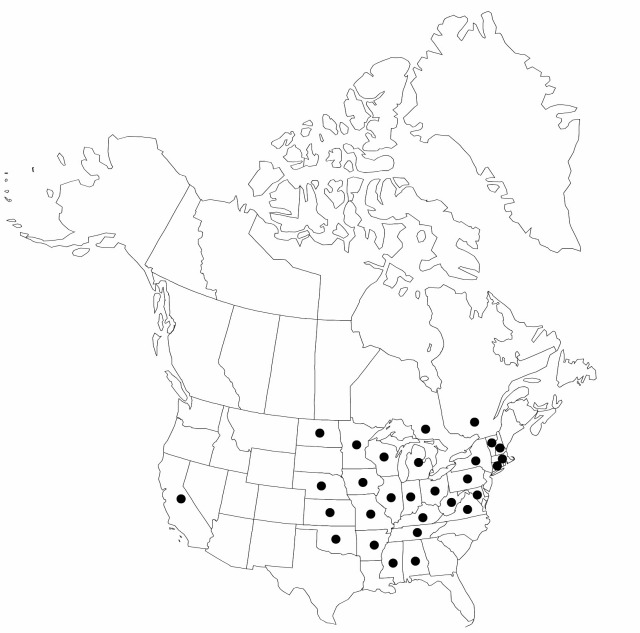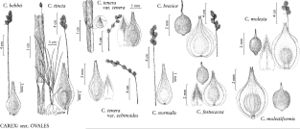Difference between revisions of "Carex molesta"
Trillia 9: 4, 20. 1930.
FNA>Volume Importer |
imported>Volume Importer |
||
| (3 intermediate revisions by 2 users not shown) | |||
| Line 8: | Line 8: | ||
}} | }} | ||
|common_names=Carex dérangeant | |common_names=Carex dérangeant | ||
| + | |special_status={{Treatment/ID/Special_status | ||
| + | |code=F | ||
| + | |label=Illustrated | ||
| + | }}{{Treatment/ID/Special_status | ||
| + | |code=E | ||
| + | |label=Endemic | ||
| + | }} | ||
|basionyms= | |basionyms= | ||
|synonyms= | |synonyms= | ||
| Line 33: | Line 40: | ||
-->{{#Taxon: | -->{{#Taxon: | ||
name=Carex molesta | name=Carex molesta | ||
| − | |||
|authority=Mackenzie ex Bright | |authority=Mackenzie ex Bright | ||
|rank=species | |rank=species | ||
| Line 47: | Line 53: | ||
|publication title=Trillia | |publication title=Trillia | ||
|publication year=1930 | |publication year=1930 | ||
| − | |special status= | + | |special status=Illustrated;Endemic |
| − | |source xml=https:// | + | |source xml=https://bitbucket.org/aafc-mbb/fna-data-curation/src/2e0870ddd59836b60bcf96646a41e87ea5a5943a/coarse_grained_fna_xml/V23/V23_660.xml |
|genus=Carex | |genus=Carex | ||
|section=Carex sect. Ovales | |section=Carex sect. Ovales | ||
Latest revision as of 20:42, 5 November 2020
Plants cespitose. Culms 35–110 cm; vegetative culms few, inconspicuous, usually fewer than 15 leaves, not strikingly 3-ranked, leaves clustered at apex. Leaves: sheaths adaxially green, narrow hyaline band near collar, adaxially firm, summits U-shaped, smooth; distal ligules 1.5–3.2 mm; blades 3–6 per fertile culm, 12–38 cm × 1.5–4 mm. Inflorescences erect, ± congested, green to light brown, 1.3–3(–3.5) cm × 7–16 mm; proximal internode 1.5–6 mm; 2d internode 2.5–6.5 mm; proximal bracts aristate, with bristle tips shorter than inflorescences. Spikes 2–4(–5), overlapping, globose to ellipsoid, 6–16 × 5–12 mm, base and apex rounded; terminal spike usually lacking conspicuous staminate base. Pistillate scales hyaline-brown, with green or pale midstripe, ovate, 2.9–3.5 mm, much shorter and narrower than perigynia, margins pale, apex acute. Perigynia (25–)30–80 per spike, spreading at maturity, ascending-spreading, pale brown, conspicuously 5-veined or more abaxially, conspicuously 0–6-veined adaxially, elliptic to ± orbiculate, plano-convex, (3–)3.3–4.8(–5.7) × 1.8–3 mm, 0.5–0.6 mm thick, 1.2–1.8 times as long as wide, margin flat, including wing 0.4–0.8 mm wide, smooth; beak light brown at tip, flat, 0.7–1.6(–1.8) mm, ± ciliate-serrulate, abaxial suture with white or hyaline golden brown margin, distance from beak tip to achene 1.6–2.6 mm. Achenes elliptic to narrowly oblong, 1.3–1.7 × 0.9–1.3 mm, 0.5–0.6 mm thick. 2n = 68, 70.
Phenology: Fruiting early summer.
Habitat: Fields, roadsides, bottomlands, open woods, on dry to wet, often heavy, calcareous soils
Elevation: 100–700 m
Distribution

Ont., Que., Ala., Ark., Calif., Conn., Ill., Ind., Iowa, Kans., Ky., Md., Mass., Mich., Minn., Miss., Mo., Nebr., N.H., N.Y., N.Dak., Ohio, Okla., Pa., Tenn., Vt., Va., W.Va., Wis.
Discussion
Carex molesta, often somewhat weedy, is introduced in California.
Selected References
None.
